Photos: Werner Ernst and Roz Neave
One of the great powerhouses of Holstein breeding is the farm of the family Thormählen where they have been breeding horses for 440 years. Rheder Thormählen started breeding jumping horses after the Second World War, and his son, Harm took over the yard in 1973. This has been the birthplace of many famous horses such as Capitol and Cera, and Harm Thormählen is regarded as one of the smartest jumping breeders in the world today.
“Two years ago we had a party – it was 440 years that this farm was in the family – always with horses,” Harm told me. “Here they used to work with horses always. They had to work very hard, the ground here is very special. If you try to plough one hour too late, then the ground is hard like cement. The horses had to work very hard.”
The great mare, Retina
“In 1950 came the first tractor, and the mares went to the butcher – they no longer needed horses! But my father, Rheder Thormählen was interested in horses – after the war he was an international showjumper, and he dealt a lot of horses, this was his hobby. I don’t remember it myself, but Alwin Schockemöhle told me, my father was one of the biggest dealers in Germany. His hobby was to buy international showjumpers, famous mares who were Grand Prix showjumpers, and 40/50 years later, comes the result from those famous mares. Even at that time, those mares were very expensive. We only breed for jumping on this farm.”
Harm lets his babies play at being jumpers in the arena…
Do you breed mainly for the German or foreign market?“Ninety percent go out of Germany.”
The prices are still good for jumping horses?“It is very specialized. The top top are okay but with the normal horses we have big problems. The cost to raise the normal horses is three or four times more than what you can sell them for. We have to sell them very early, get rid of the normal horses cheap.”
“What I try to do is buy the very good fillies when they are foals, then I try to breed a filly out of her, and sell the mare into the sport… sometimes with an agreement that I get her back at the end of the competition career. That way I can keep making the mares better and better.”
An Update by Adriana van Tilburg (August 2015)
If you are interested in breeding jumping horses, then you should try to visit the famous breeder, Harm Thormählen! Not only is he fascinating to listen to, he also has an incredible wealth of knowledge thanks to his longtime experience as a rider and breeder.
The great jumping stallion, Capitol
And his full-sister, U-Capitola, the dam of Quite Capitol
And her daughter, Birte II, by Landgraf, the dam of the three Quite Eaasy brothers and Casir Ask… Quite Easy I stands in France with Bernard le Courtois – while Casir Ask has been an important sire in Denmark.
We all know Capitol (by Capitano out of Folia by Maximus) who was bred by Harm out of the Stamm that he made famous, Stamm 173. Harm recalls: “I sold Capitol as a foal together with several other foals to Maas J. Hell and he secured him for the Holsteiner Verband. His free jumping was unbelievable. He did the free jumping for several years at the Holsteiner Verband stallion presentation. In 2000 and 2001 he was the best stallion for jumping horses in the WBFSH Ranking. At the Olympic Games in Sydney, 2000, he had three direct offspring; Carthago, Campione M and Cento and at the Olympic Games in 2004, Athens, he had four direct offspring; Cardento, Casita, Cento and Goliath.”
Starring in Sydney… Cento
But the adventure goes on… While I was doing this interview, Harm was free jumping his next generation of stars, the two, three and four year olds.
Harm emphasized how important it is to not stress the horses, they need to have positive experiences and must learn that jumping is not scary. He instructed his team on how to handle the horses.
One colt is nicknamed ‘Bandito’, apparently he has earned it. Harm says: “This colt is so strong in his head, he will do everything he wants and not what we want. His free jumping looks very good, and horses which are special often reach top level. I have had many horses with a special character in my stable (not evil) and the most of them reached top level. You need to invest time to get them on your side and have a lot of patience and reward so that they will become fantastic sport horses. He learned a lot the last weeks and I believe he will do in the end what we want him to do.”
Like most horse breeders Harm is also a horse dealer and has contacts all over the world. He discovered Come On (by Cantus out of Suehne by Landgraf I):
“ I rode Come On as a young horse in competitions and later he was leased to HRH Princess Haya. I was owner of the breeding rights and Ralf Schneider the owner of the sport rights. Schneider was the sponsor of Ludger Beerbaum. Come On was also qualified for the Olympic Games in Sydney in 2000.”
The contact stayed and Harm Thormählen is the breeder of the stallion Cero (by Calido out of Larsa I by Come On) who is owned by HRH Princess Haya and is competing at 1.60m level with Francois Mathy Jnr.
How did you start breeding?
I was a show jumper and I wasn’t serious about breeding. Jumping was more enjoyable for me because I had good results and that made me eager for more. I jumped the German Junior Championships when I was 16 or 17 years old. When I was about 19/20 years old we got Gera (by Galvani out of Vorrbuch by Heidenstamm, Stamm 3615) and Ringo (by Frivol xx x Romanze by Ramzes x, Stamm 6879) and we kept them a bit longer so I could compete with them in sport and they were eventually also sold. Gera jumped at international level and Ringo jumped at the Olympics in Mexico, 1968, with Masayasu Sugitani from Japan.
My father bought the mares as hobby, and I started with breeding after I took over the farm, it is a part of my business.
What mares did you have when you started your breeding operation?
“The mares were world class mares, they all competed at international level. I started with several good mares when I took over the farm. There was the famous Retina (by Ramzes out of Dolli by Lopshorn, Stamm 104A) who is mother of Capitano (by Corporal) and she also starts the branch of Corradina (by Corrado I out of Elsafina by Sandro) who had a lot of success in the international sport with Carsten Otto Nagel.
Vase (by Ramzes out of Rappel by Heinzelmann, Stamm 173) belonged also to this group … and her daughter Folia (by Maximus) produced six approved stallions: including Capitol I/III (by Capitano), Latus I/II (by Landgraf I) and Cellebrio (by Caletto II).
Soleil, by Capitol, the dam of Corrado I and II
Another was Contiane (by Fanal out of Organisation by Heinzelmann, Stamm 6879) she is the great-great-grandmother to Corrado I. No one remembers today that my father and I started the branch of Corrado I. We bred Tamino (by Frivol xx) out of Contiane and when I was 17 years old, her full sister bucked me off in such a way that I was happy that I had taken judo classes because I knew how to roll over, but it didn’t prevent me from breaking my two arms… Another full brother to Tamino was like Fein Cera, he had blood, long legs and was very clever. My father sold him for a lot of money to Switzerland. The half-sister to Tamino was Romanze (by Ramzes) and she had a colt by Frivol xx, Ringo. I rode him in several Grand Prix and won also several Grand Prix, he was sold to Japan to become an Olympic jumping horse. He competed in Mexico at the Olympic Games, but he had to be put down on the plane because he started to panic on the way home. He was the only horse in the Japanese team that finished the course, it was extremely tough. The Germans won the bronze medal with 50 faults, it was that tough. My father and I played also a role in purchasing the father of Corrado I, Cor de la Bryère. I persuaded Jasper Nissen and Maas J. Hell to go to France with some delegates from the Holsteiner Verband, after we heard from Alwin Schockemöhle that there were some really interesting stallions in France. Maas J. Hell made it possible that Cor de la Bryère came to Holstein.
Harm with Fein Cera and Cera – Photo Werner Ernst
Gera (by Galvani out of Vorrbuch by Heidenstamm, Stamm 3615) came in a later period to my mare herd. We bought Gera as a five-year-old after my father and I have seen her at a show. I rode Gera the Nation Cup in The Netherlands as a 19-year-old, and Gera was at that time six year old. I have the most horses from her line. I rode ten 1.40m classes with her and they were difficult courses, we didn’t think about how the jumps were built we just jumped. I jumped also over a two meter fence with her in Dobrock and we became second in a GP*** when she was six-years-old. She was not so big and looked a stallion with a fantastic canter, hindquarters and neck. She didn’t look so small. Eventually after a sports career with different riders and owners she came back to us to become a broodmare.
Capitol I is the most famous horse that I have bred. His scope was unbelievable and he passed his scope on to his offspring. He crossed really well with mares with Sacramento Song xx or with Cor de la Bryère blood, he needed mares with blood. His pedigree is interesting because he has Ramzes x twice in the pedigree.
Ringo was the first top horse that I bred and like I said, he jumped at the Olympics. Ringo would have cost nowadays about five million euro, he had so much quality and was very good to ride.
Different Studbooks are looking for a new top stallion. But it seems that the Holsteiner Verband and also the KWPN are losing direction. What do you think about this?
Yes of course, all Studbooks are looking for new top stallion but that is very difficult. I have to say that I see in the Oldenburger Jumping Studbook a lot of good stallions, who jump really good.
Do you think that the German Studbooks will become one in the future?
Yes, this will happen in the future and I am not afraid of it. I think it will be productive. Who knows the future of our studbooks? Clients know what a good horse is, and they buy a good horse, the international market only wants a good horse, it doesn’t matter if it is a KWPN or a Holsteiner horse. Off course I would prefer that the Holsteiner horse will stay, but all studbooks will have a very hard time. But most of the clients are not interested in papers, they want to have a horse with a good character and they don’t need to compete at a high level. The Studbooks are also way too expensive, you have to pay so many costs. It won’t take long before we have one German Studbook. I think that the KWPN, BWP and SF will stay.
What are your selection criteria for choosing a stallion?
Stallions need to perform at international level and they need to have a good pedigree. They must have the willingness to jump and it is not enough anymore that they jump high, they also need to be modern in type.
(While I was interviewing Harm, one of his grooms came into the arena with a colt and let him go. She didn’t look at the young horse once he was loose, and Harm noticed that. He gave her advice about how she can better handle young horses.
“Young men are naughty and you always need to be careful when you turn them loose because they can turn around and kick out, it will go well about 1000 times but when it goes wrong, it will go seriously wrong. You have to react quicker in moving away from a young horse…”)
I am not restricted to a Studbook, I use what I like. It can also be a very good son from a sire that is performing at international level. The stallion also needs to have a good and strong mare line. I call Joachim Tietz, Jac Remijnse or Xavier Leredde if I want more information about a certain mother line, they know so much about the mare lines. Plus I talked a couple of times with Francois Mathy Sr. and he knew a lot about the Belgian mare lines, he had so much knowledge about horses! They helped me with what I didn’t know. I know of course the Holsteiner mare lines.
I think the pedigree is important. Take for example Casall, I know that there are more good competition horses from this family. The mother line needs to be good.
Are there in Holstein good mare lines that we need to make sure don’t disappear?
The mare lines won’t disappear, the breeders who think will keep breeding with their mares. Because these horses are wanted. I noticed in Ireland that the breeding there makes a few steps backwards. About 50 years they ago they ruled the world market for jumping horses, they had a lot of good international competition horses, only the Irish made a mistake, the breeders sold their best broodmares. They continued with less good quality mares.
Doesn’t the foreign press say the same about Holstein?
Yes… But not everybody does that. I don’t sell my best mares or I sell them after I have bred a filly from them.
I think that the normal riding horses will not ever become expensive again. There is not much money, the children need to go to school in the afternoon. In Germany we have clearly less riders than we had some years ago. It is also expensive to keep horses. If you want to buy a horse you need stables where you can rent a box, there are becoming less stables, and those who are offering them are not earning a lot of money. Because of all this we are not able to find riders who want to start with young horses. Plus many of the young riders today don’t know how to ride properly. When I was young we were taught In a decent way, how to ride, it was part of our culture.
Many breeders in Holstein don’t have children who can or will take over the farm, how will this affect you?
This will be a generation shift. This already started for the economic crisis and became more visible because of the crisis. There is no money to earn with normal horses. I have once a month, a ‘Stammtisch’ a gathering with breeders from my area so we can exchange ideas and experiences. They all have nobody who will continue with horse breeding. China and India are buying mares, they will continue with what we bred. Like the Netherlands 30 years ago, Wiepke van de Lageweg bought several good mares from me and others in Holstein and so became competition for us. But only the best survive, the one ones with the best knowledge and management, and this is lacking in countries like China and Indonesia.
How can you share your knowledge because this will be gone when you die?!
(Harm is laughing) Do you really think I will share all my knowledge with everybody? There is no reason to think that. Philipp Baumgart will take over the farm in the future. He rode all my good young horses and knows my horses very well. He rode Cera and Fein Cera when they were young. We are already working for a long time together and he is my nephew. He has the world market in his head and most of our horses are sold outside Europe, he has some really good ideas.
How do you select mares?
I do a lot of free jumping, that gives me a lot of information. Their interior needs to be very good, that is for me the most important quality. I can accept some problems in the conformation when the mares have a very good interior. You learn that by experience, by knowing the mare lines. Being raised in a herd is also important for mares and stallions because they learn to interact in a hierarchy. There you can also learn as a breeder or owner a lot about the character.
How do you think about inbreeding in Holstein?
We don’t have so much inbreeding. The Holsteiner book has been opening up for quite a few ‘outside blood’ stallions. We will see if they will get a foot on the ground in Holstein. We see it in Oldenburg, everything is being bred there with stallions with at least 50 % Holsteiner blood. We also had once 80 % of Holsteiner blood at the Oldenburger stallion approvals. Everything that is jumping somewhere worldwide is being accepted. Oldenburg is catching up on us (the Holsteiner Breed). We need to think modern here in Holstein and we need to do our best to keep the breed at a good level.
Harm’s motto is: “What doesn’t kill you makes you stronger and you have to be honest and fair and not to be jealous when clients are having success with your horses that is a huge mistake. Because clients who have good results with the horses will come back to buy more horses. Look and learn from successful people what they have done, and what they have done better.”

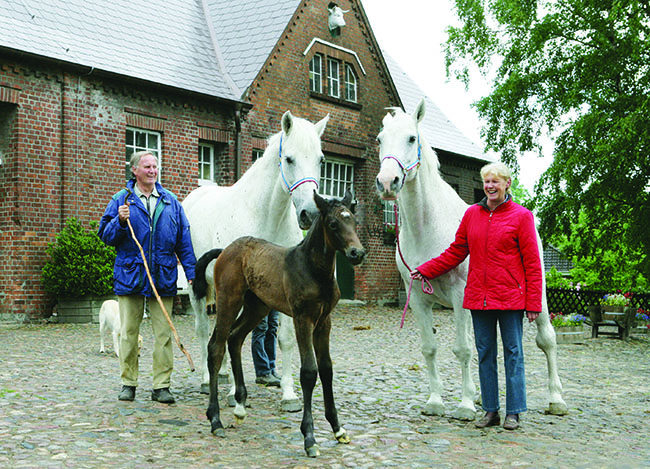
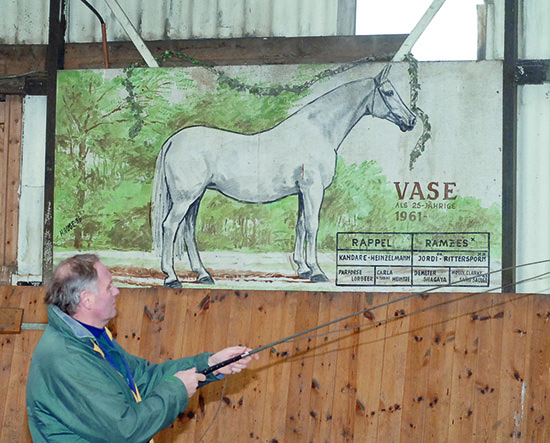
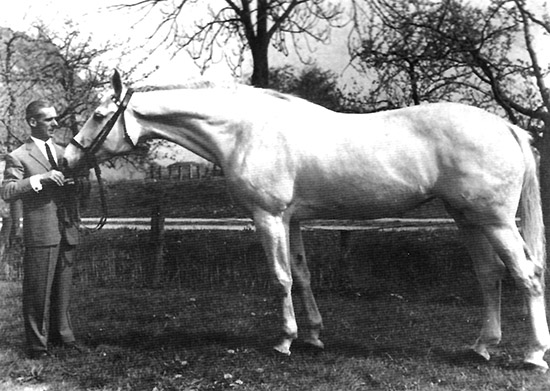
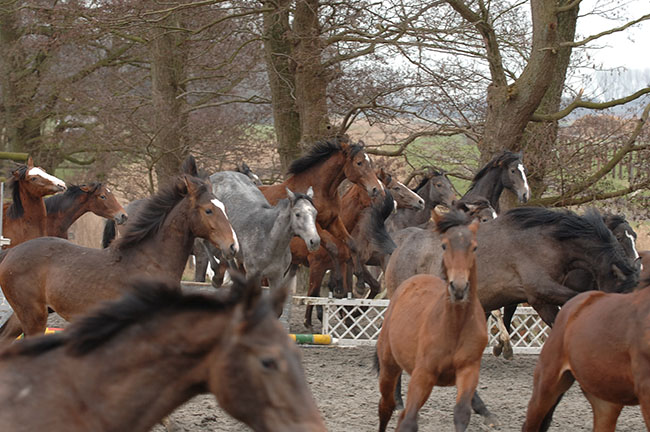
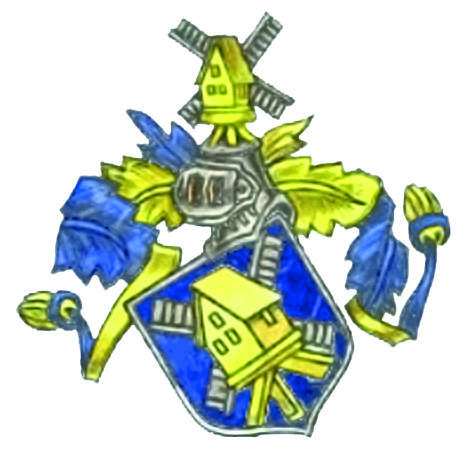
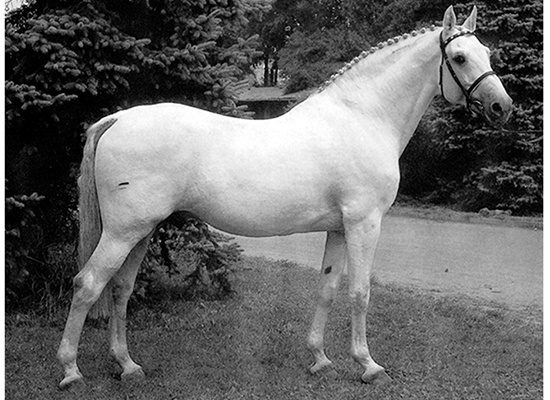
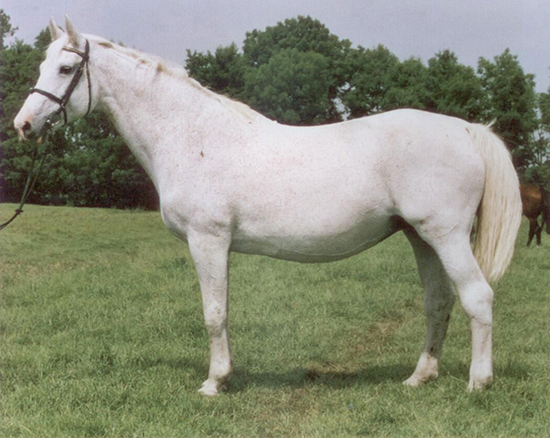
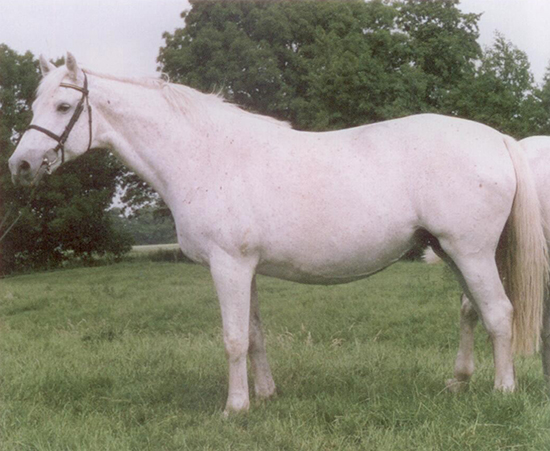
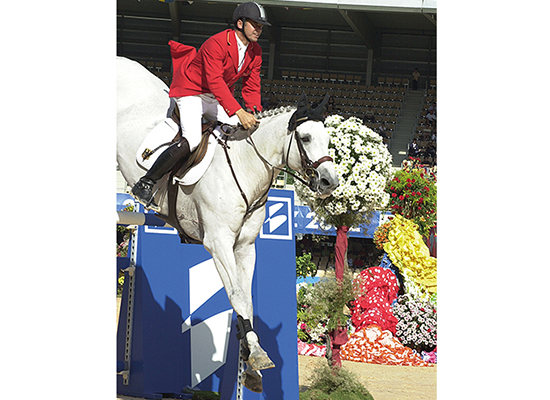
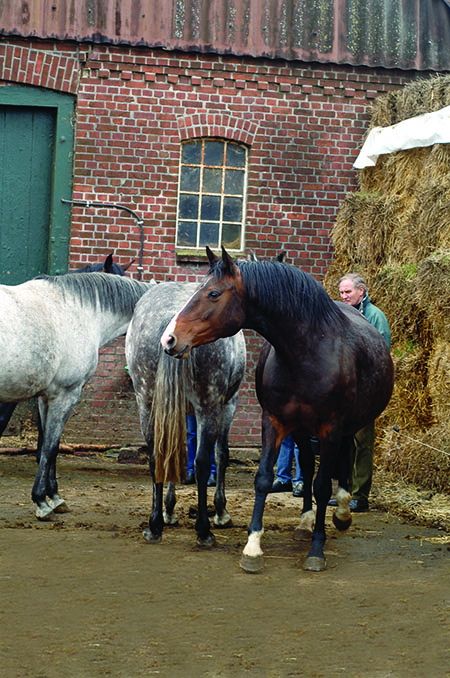
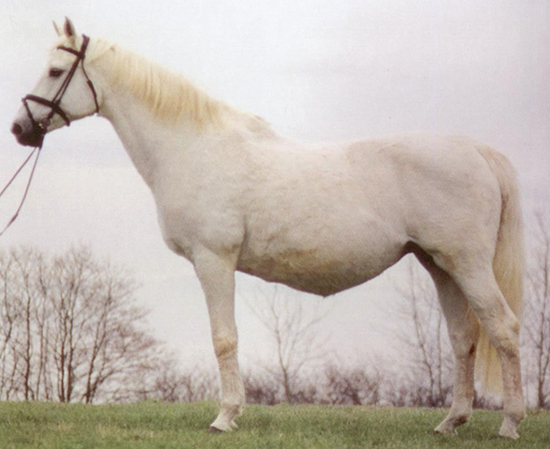
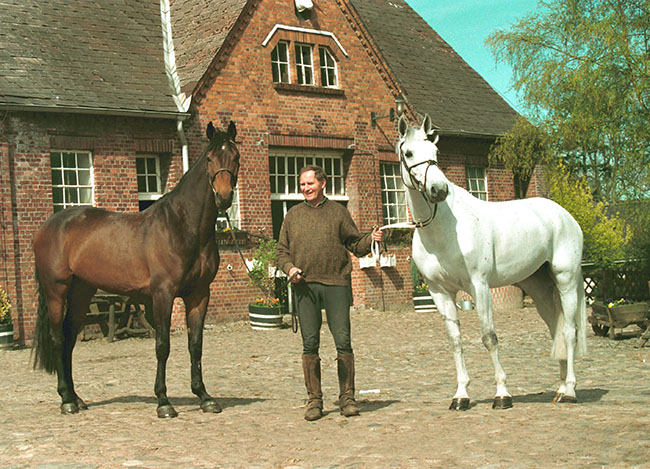
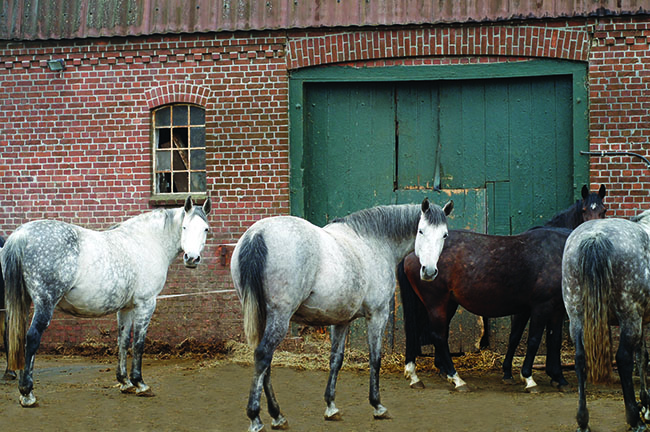
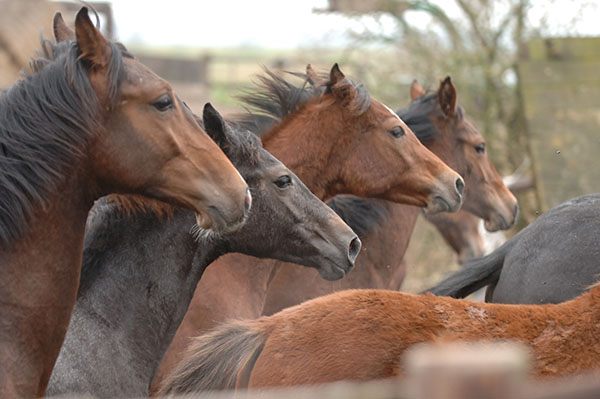
I’m looking for anyone who owns the rights to the picture above of Retina. Do you have any information on that? Thanks.
If you mean the drawing of Vase on the wall, Roslyn Neave of The Horse Magazine, took the picture.